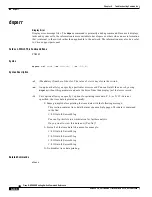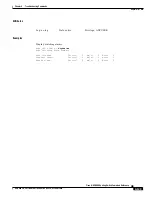
9-117
Cisco MGX 8850 Routing Switch Command Reference
Release 2.0, Part Number 78-10467-04 Rev C0, October 2001
Chapter 9
Troubleshooting Commands
dsplog
dsplog
Display Log
Display log file contents. The dsplog command is a debugging command and requires in-depth
knowledge of the internal workings of the system. For example, the display may show points where the
switch software steps into and out of functions or tracks tasks that it is spawning.
The PXM45 supports multiple log files: if the space allocation for one file becomes exhausted, the
system starts filling a new, sequentially numbered file. The log files contain a substantial variety of
information. With no parameters, the output contains all the contents of all the log files, so dsplog
provides optional parameters for filtering the output. For example, you could specify only severe errors
and only for a particular slot. The Syntax Description describes each parameter. Briefly, their functions
are to:
•
Specify an individual log file.
•
Target a specific task.
•
Specify an area of system functionality (called a module in the syntax).
•
Display messages of a particular severity.
•
Specify relative time periods in which errors may have occurred.
Cards on Which This Command Runs
PXM45
Syntax
dsplog
[-log <filename>]
[-sl <slot #>]
[-task <task name>]
[-mod <module name>]
[-sev <severity>]
[-tle <time same or earlier than>]
[-tge <time same or greater than>]
Syntax Description
-log
Specifies the filename of the error log. If you do not specify a file, the output scrolls
through all log files one file at a time. To see a list of the existing log files, execute
dsplogs.
-sl
Specifies the slot number for which to display errors.
-task
Specifies the task for which to display errors.
-mod
Specifies the module or functional area of switch software. The categories are
numerous. Examples are: node alarm manager, card alarm manager, inter-process
communications.
















































